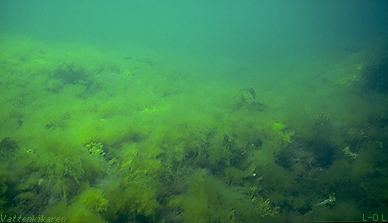 |
|
How shallow bays are effected by eutrofication

| The fast growing green alga creates a fluffy covering
on the bottom and over the perennial and relatively slow growing
alga. |
Generally, with over-fertilization in shallow
bay areas along the Swedish west coast, it is the perennial eel grass that
lose while competing against the annual and fast growing algae. The annual
algae are so called opportunists, meaning that they quickly colonize
areas that are rich in resources.
An increase in food resources favours macroscopic algae, that
are thread-like, have a short life and are fast growing. These algae are
epifytes (grow on or around a host) on the perennial algae, which
run the risk of being eliminated when light sources are cut off (or partially)
so photosynthesis is not as effective. Powerful waves can tear loose many
of the finely threaded algae and throw them up onto the beach where they
lie and rot. In protected bays that are over-fertilized, the finely threaded
algae are able to exist without any host to anchor them. Instead they build
large mats over the bottom or lumps that float around.
Those algae that have increased in shallow bays because of
over-fertilization come mainly from the following families: Cladophora,
Enteromorpha,
Ulva,
Ulvaria, Ulothrix and Rhizoclonium.
 |
Page
17 of 28 |
 |
|



